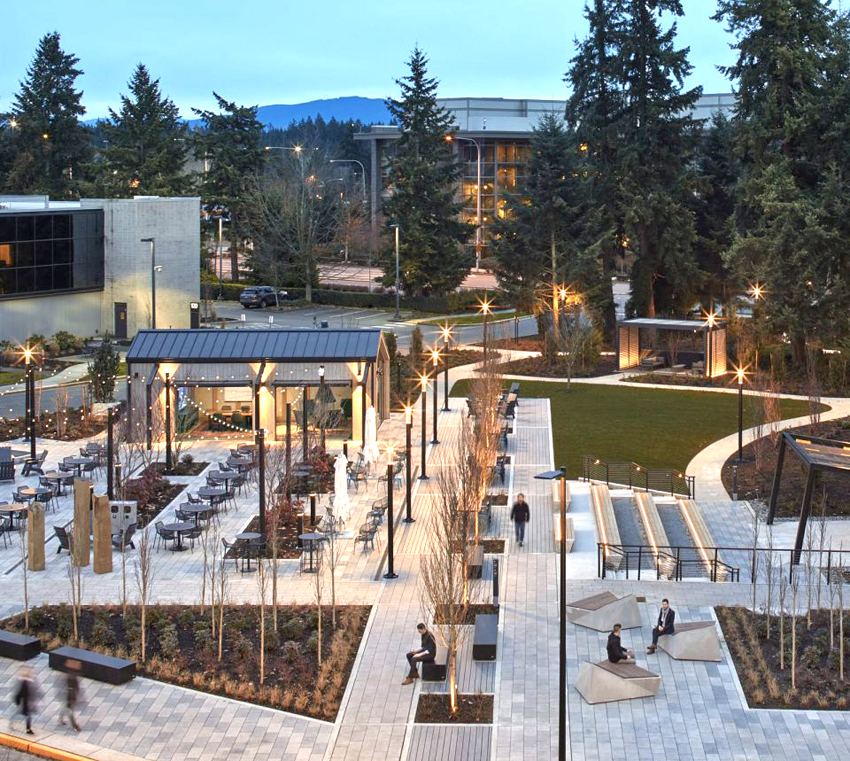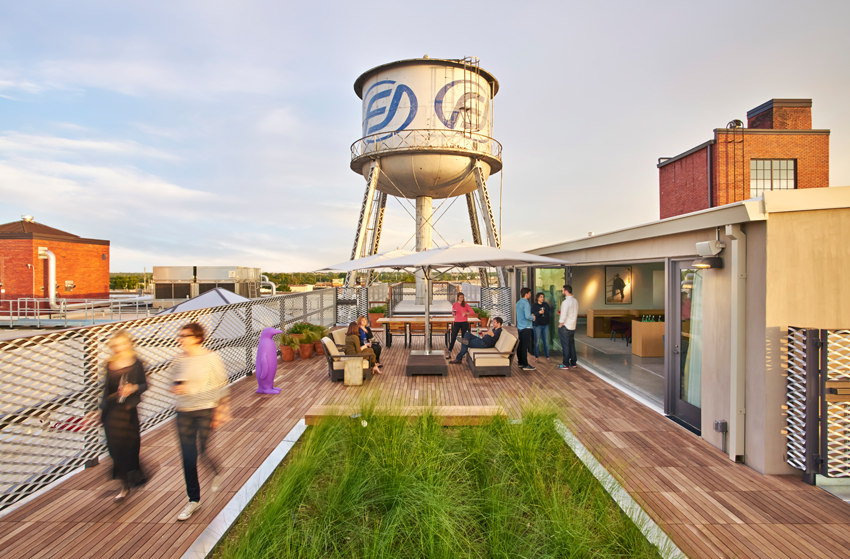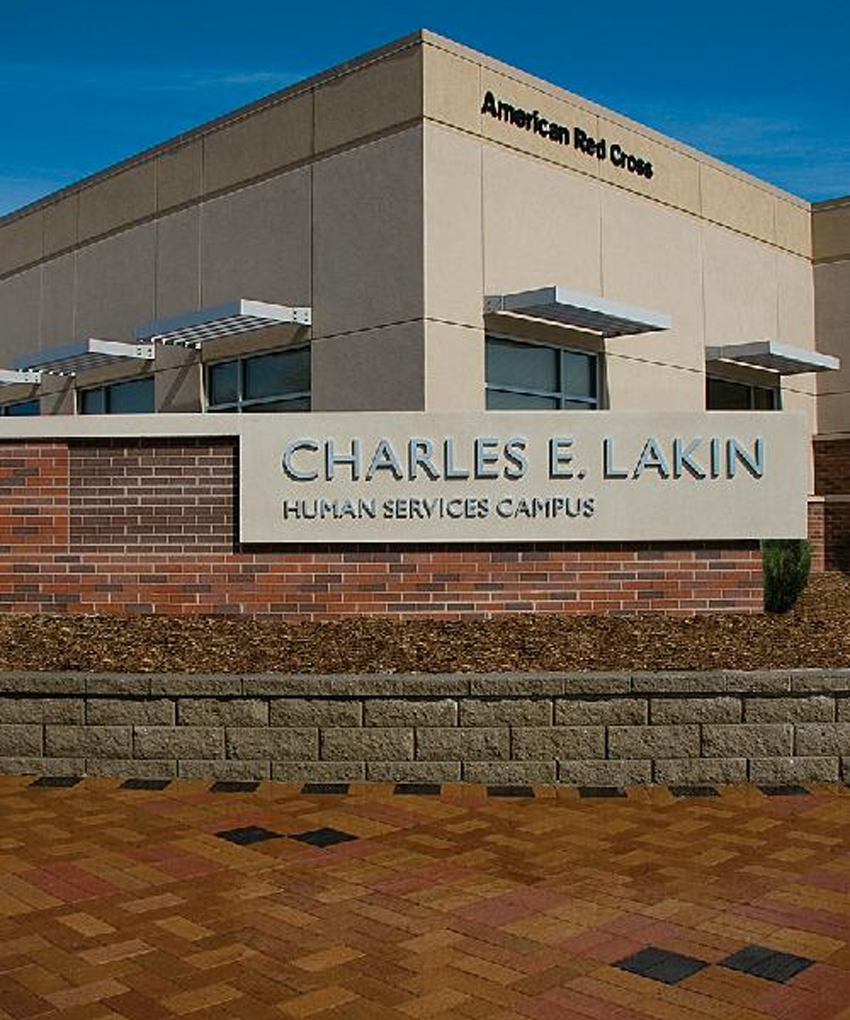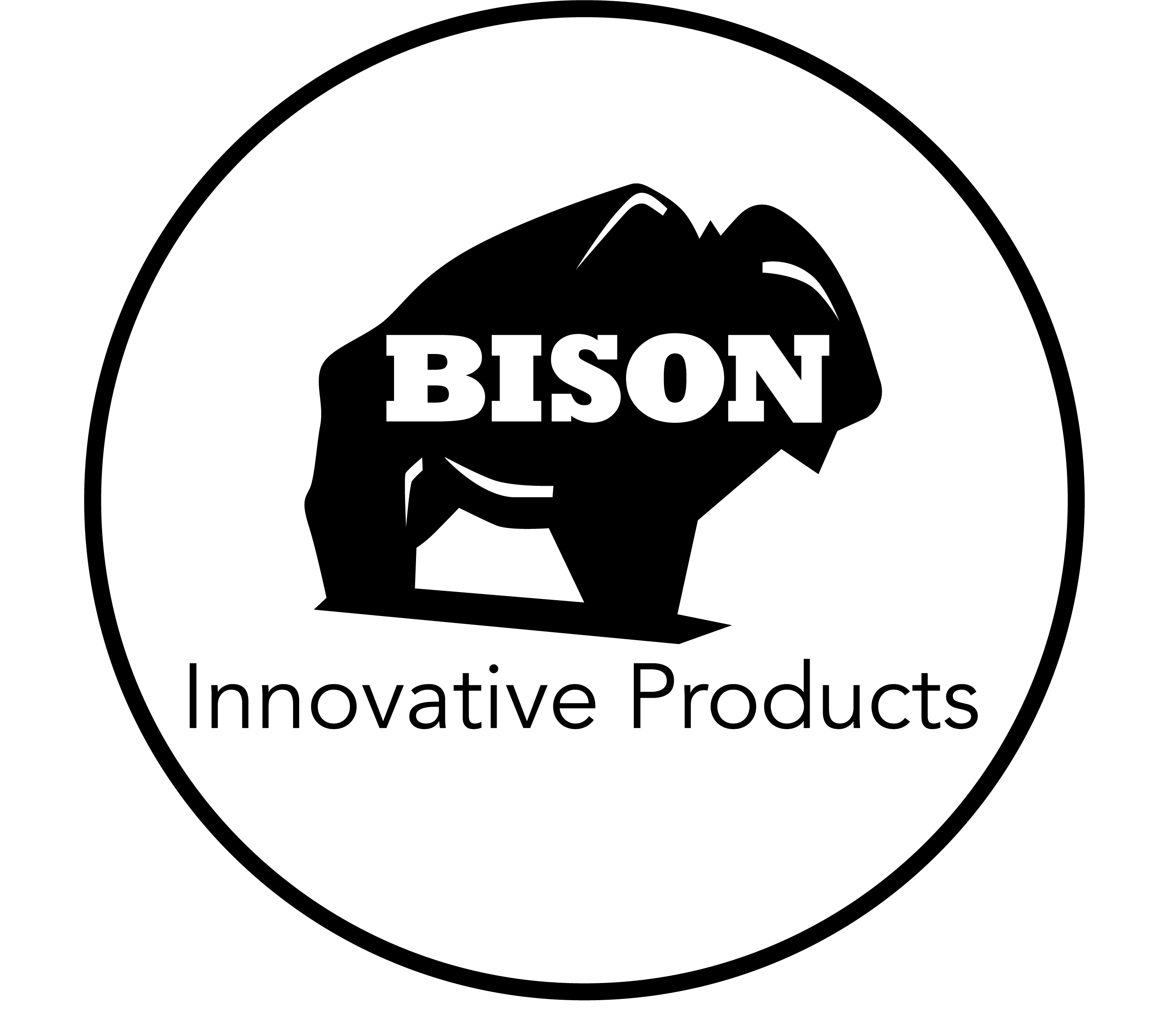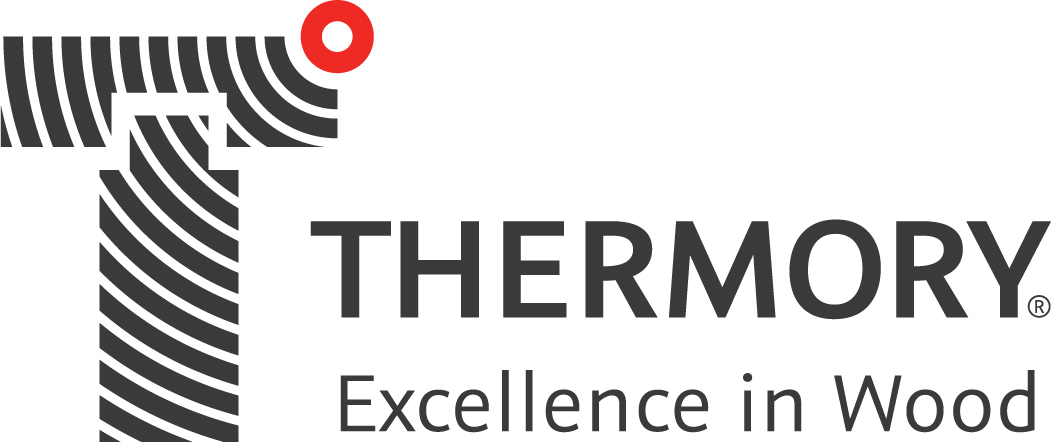This CE Center article is no longer eligible for receiving credits.
Expanding Outdoor Spaces With Outdoor Structures
Current design strategies put a great deal of emphasis on expanding outdoor living spaces, as outdoor environments provide both mental and physical health benefits. Outdoor structures can be extremely flexible in size, configuration, and design, giving architects and designers maximum creative options in designing outdoor environments. Outdoor structures are available with decorative options to control sun shading, wind and bug protection, and privacy, thus providing protection from sun, rain, wind, and flying insects and extending the use of outdoor spaces.
Outdoor structures are engineered so that they can enhance recreational and work environments for health-care, hospitality, commercial, and residential settings. These outdoor structures are designed to withstand and function in a number of weather conditions, as the roof louvers and side panels keep out sun, rain, and wind. These structures are designed for hurricane-force wind loads, with a Miami-Dade rating for certain sizes, and have temperature and rain sensors built in so that roof louvers will automatically close at the start of a storm. Side panels can be either shade screens or glass panels, and both help to buffer against wind.
The outdoor structures are available in a number of sizes and design options. Sizes range up to a maximum size of 14.75 feet x 20 feet to even larger if pergola structures are joined. Pergola structures include:
- Square design models that have either a tilting and/or retracting louvered roof or an inoperable stretched fabric ceiling with a drainage system above.
- Incline design models that have retractable fabric roof coverings.
- Frame-only structures with no louvers or fabric coverings. These models allow for the planting of vines on the structure.
Structures are constructed of powder-coated aluminum with stainless steel hardware. The shade fabric is fire rated.
Options for Enclosing Outdoor Structures: Shades and Sliding Panels
Outdoor structures offer a sun-protection roof system through louvers. Louvers work via rotating blades, with each blade channeling water to the beam. The extruded aluminum blades rotate up to 150 degrees and thus enable the user to decide how much sun protection and/or ventilation is required. The closed louver blades form a waterproof roof under normal shower conditions. A gutter system drains the rainwater in the beams and down the columns of the outdoor structure.
Designers have the option of having up to five glass skylight blades in the louver system. The skylight blades obviously let in more sunlight during the day. There is also an option of having LED louver blades to provide nighttime lighting for the interior of the structure. Other LED options include cove-mounted up and/or down lighting and vertical column lighting on the inside corner of columns in either white or RGB color. All of the LED options are dimmable.
Shades offer wind and rain protection along the sides of the outdoor structures. Shades are operated using the same remote control and employ a “zipper” roll shade system that secures the fabric edges on the sides to keep wind and bugs outside. The zip shades come in various sizes. The Medium size option is 157.5 inches wide x 106.35 inches high. Large size options are 236.25 inches wide x 133.75 inches high. The fully integrated zip shades can be hidden inside the beam as an option for maximum passage height under the beam, or shades can be surface mounted in a matching headbox as another option depending on conditions and structure type.
Shades have a locking zipper side channel, which allows the shade to keep out wind, rain, and insects. Side channels were originally created for Japanese bullet trains, when speeding through tunnels pushing a shock wave of air that would blow roller shades out of their side channel. Now perfected for exterior use, the zipper fabric lock keeps the shade flat and smooth, and seals the edges to keep bugs out. It can even keep golf balls from breaking windows.
Shades can be mounted either on the interior or exterior of the outdoor structure, but the exterior mounting provides several advantages that also help to meet LEED and SITES criteria:
- With exterior shades, the heat stays outside the structure. The designer can use darker fabric colors to improve shade visibility without concern of heat buildup on the interior of the structure because of the locking zipper side channels.
- Exterior-mounted shades keep the mechanicals on the exterior of the structure so they are not visible from the inside.
- Exterior-mounted shades keep the interior of the structure and the windows cleaner if a combination of exterior shade and glass panel are used for the outdoor structure.
All exterior shades meet 80-mph wind resistance against the windows and 31-mph wind resistance in the open. They meet a Wind Class EN13561. A wind-resistance class is determined for every outdoor shade, screen, and blind system, accredited after strict laboratory testing as specified in the European Standards. The EN13561 references the testing standards for External Blinds and Awnings. Wind-resistance classes are set based on wind speeds:
- Class 1 = wind speed 28 km/h (beaufort scale 4 – 40 N/m)
- Class 2 = wind speed 38 km/h (beaufort scale 5 – 70 N/m)
- Class 3 = wind speed 49 km/h (beaufort scale 6 – 110 N/m)
Note: The Beaufort wind scale was developed and named for British admiral Sir Francis Beaufort (1774–1857) who developed the scale in 1805 to help sailors estimate the winds via visual observations. The scale starts with 0 and goes to a force of 12. Hence the term N/m, which stands for Nautical miles.
The shades have hidden electrical wiring and use a smooth side channel for stability. Both the louvers and shades are motorized and UL electrical listed. Medium shades can also be solar powered because of a photovoltaic cell that can be mounted on the shade enclosure or nearby.
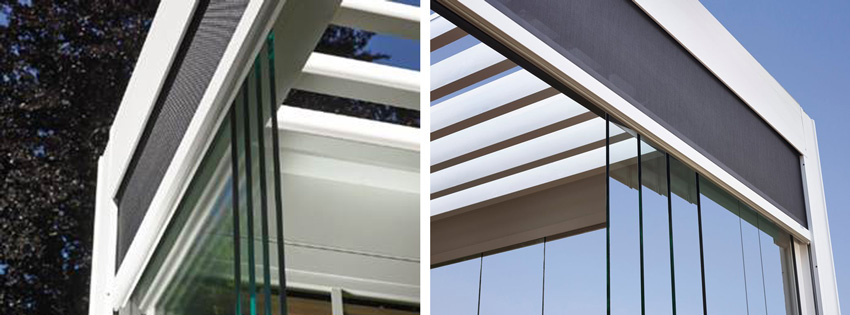
Photos courtesy of Renson Inc.
This outdoor structure features rotating roof louvers and exterior side louvers.
Outdoor structures meet the following LEED and SITES criteria for designers.
Sustainable Sites 8: Light Pollution Reduction (1 point)
The motorized shades contribute toward 1 point with automated solutions for shading devices, eliminating light pollution by blocking artificial light to the outside during evening hours.
Sustainable Sites 1: Energy & Atmosphere (4–11 points)
The mechanized and solar sensitive shading systems contribute toward up to 11 points by helping to optimize the energy savings of the artificial lighting systems and HVAC.
LEED Indoor Environmental Quality 6.1: Controllability of Systems – Lighting (1 point)
The shading systems contribute toward 1 point through the management of scenes between the lighting and solar-protection systems.
LEED Indoor Environmental Quality 6.2: Controllability of Systems – Thermal Comfort (1 point)
Motorized shades contribute toward 1 point by the dynamic insulation solution interacting with the heating and cooling systems.
Outdoor Spaces Benefit People and The Environment
Outdoor spaces provide many opportunities for landscape architects, architects, and designers to expand a project’s used beyond the building walls. Particularly in this time of COVID-19, ground-level plazas, patios, outdoor decks, outdoor structures, and roof gardens provide opportunities for healthy socialization, as they offer additional room for building users to interact in compliance with social distancing. The material palette for expanding into outdoor spaces includes thermally modified wood for decking, a variety of natural stone and permeable gravel surfaces, brick pavers, modular deck tiles and planters, and pergola structures.
There are a number LEED and SITES strategies that can have a positive impact on a person’s health and well-being and well as the environment. On-site plazas, roof gardens, and outdoor decks that are easily viewed and accessible from a building interior benefit building users and occupants while also providing LEED and SITES credits. Wood decking, clay-paver plazas, metal and wood planters, and wood-tile roof plazas are products that provide designers with multiple options for landscape architectural placemaking. Products that are sustainably produced and transported and provide reduction in heat island effect help to meet LEED and SITES criteria while also producing environmental benefits. Outdoor spaces that provide opportunities for physical activity, social interaction, safe site accessiblity, and equitable use of a site meet multiple criteria in the Human Health and Well-Being section of the Sustainable SITES rating system. And landscape architectural designs that expand user opportunities outside of the building provide wholistic benefits to both people and the environment.
END NOTES
1Cellulose is an insoluble substance, which is the main constituent of plant cell walls and vegetable fibers such as cotton. It is a polysaccharide consisting of chains of glucose monomers.
2Hemicellulose is any of a class of substances which occur as constituents of the cell walls of plants and are polysaccharides of simpler structure than cellulose.
3RAL is a European color-matching system that defines colors for paint, coatings, and plastics. The RAL color standard is administrated by the RAL Deutsches Institut für Gütesicherung und Kennzeichnung. RAL is the abbreviation of Reichs-Ausschuß für Lieferbedingungen und Gütesicherung. This name can be translated in English as National Commission for Delivery Terms and Quality Assurance.
4A bituminous setting bed is basically a sheet mix of asphalt, screeded by hand similar to how a sand setting bed is screeded. The bituminous setting bed is more expensive than sand set pavers, but it provides more longevity in vehicular applications.
Landscape architecture by definition is the practice of designing the outdoor environment. The American Society of Landscape Architects (ASLA) provides a detailed explanation of this term, stating that landscape architects have a significant impact on both the natural environment and the people who live in the surrounding communities.

Photo courtesy of Bison Innovative Products
Pop-up plazas, such as this one in Cedar Rapids, Iowa, designed by Seth Gunnerson, provide flexible design options for creating outdoor spaces in urban areas.
In designing outdoor spaces, landscape architects can play a vital role in contributing to the development of the health and well-being of communities. This is accomplished by:
- Improving and regenerating the environmental conditions;
- Providing outdoor environments that are beneficial to people’s health; and
- Planning and designing outdoor spaces that generate significant social and economic benefits to communities.
The Sustainable SITES Initiative, which was developed in 2008 through a collaborative, interdisciplinary effort of the ASLA, the Lady Bird Johnson Wildflower Center at The University of Texas at Austin, and the United States Botanic Garden, now provides voluntary guidelines and a rating system for designers to assess the sustainable design, construction, and maintenance of landscapes. The U.S. Green Building Council (USGBC) has incorporated certain SITES credit content into iterations of its LEED green building rating system, and SITES has also adapted LEED credits as part of its latest (v2) rating system.
Key design criteria of both SITES and LEED that are focused on sustainability in the design of outdoor spaces include Materials Selection, Environmental Quality, Human Health and Well-Being, and Energy and Optimization. This course will explore the ways in which designers can create attractive and sustainable outdoor environments that meet LEED and SITES criteria while also providing both social and economic benefits for the projects and their surrounding communities.
Materials for Designing Outdoor Spaces
There are a number of products that provide designers with flexibility in the design of outdoor spaces. Modular decking and pavement systems provide landscape architects with a variety of surface options for creatively designing outdoor spaces both on the ground and on rooftops. Modular cubes and outdoor structures, such as pergolas, provide opportunities for creating privacy and separation by presenting options for vertically defining outdoor spaces.
On the ground level, modular pavers can be used to define entrances, pathways, parking spaces, sitting spaces, and large open areas. Modular wood elements can be mixed with pavers or used by themselves to create unique aesthetics. Modular cubes provide spaces for plantings in rooftop gardens, decks, or parklets. Modular pergola structures provide opportunities to create outdoor rooms for shade and privacy. And all of these modular systems can be utilized in the design of rooftop gardens and decks.
Surfaces for rooftop and ground-level spaces can be designed using wood, stone, structural porcelain, crushed rock, artificial turf, grating, or concrete to create unique custom looks. All of these materials can be applied either on a rooftop when utilizing a pedestal support system or over a prepared ground-level subgrade.

Photo courtesy of Thermory USA
Thermally modified wood was used in the design of this pool deck for a private residence.
Thermally Modified Woodfor Durability, Aesthetics, And Sustainability
Thermally modified white ash, scots pine, and spruce woods are sustainable alternatives to tropical woods or composite products. The wood is harvested responsibly in Northern Europe and the United States from naturally renewable forests, making it a long-lasting alternative to tropical woods without sacrificing durability or dimensional stability. The wood is responsibly harvested by sourcing from a number of different locations around the world, thus leaving each forest healthy and thriving. This wood is also shipped via water, which is a more fuel-efficient mode of transportation than freight train and nearly 10 times as efficient as trucking.
White ash, scots pine, and spruce woods are chosen as most suitable for the thermal modification process for the following reasons:
- These are fast-growing species and thus more replaceable. This makes them a more sustainable wood species because they can be harvested responsibly, thus helping to appreciate the existing logging infrastructure as well as reduce carbon footprint.
- These wood species yield the best results via the thermal modification process, achieving a Class 1 Durability rating.
The thermal modification process uses only heat and steam, creating cellular alterations that occur on both a chemical and cellular level in the wood. The sugar content and water-absorption capacity of the wood are altered in the thermal medication process, thus modifying both cellulose and hemicellulose cells.1 Cellulose is made up of smaller units of glucose, and hemicellulose is made up of shorter carbohydrate structure, monosaccharides.2 Hemicellulose has the higher oxygen content so the cells of this cellular group can be altered by slightly burning these specific cells within the wood before burning the other cellular groups. This sequential burning process causes a reaction that creates additional heat within the wood. This thermal modification process uses the steam to control the burning process. This produces wood boards that are rot resistant for 25-plus years. It also produces wood with greater structural integrity of the fibers and dimensional stability. Aesthetically, it provides a simple, beautiful, timeless wood product that gets better with age.
Thermally modified wood goes through an extensive testing process for rot resistance, dimensional stability, termite resistance, strength, formaldehyde content, and fire spread. This testing ensures wood boards that are durable, and moisture and rot resistant. The process takes anywhere from a week to several months depending on the test. This thermal modification process is very detailed and computer controlled to ensure the same result literally every single time the wood is processed through the testing chamber
Only select northern hardwoods from U.S. and European forests, which are renowned for their well-documented sustainable forestry practices, are used to produce thermally modified woods. This fact normally satisfies the customer’s desire for an eco-friendly product, and FSC certification becomes unnecessary. However, FSC certification is offered on a case-by-case basis. This is done on a special-order basis and depends on the product needed and the size of the order and whether the FSC material is available. The FSC woods require a 25 percent price premium and an extra 12–14 week lead time to source the raw material especially for the order.
Some softwoods used in the thermal modification process are certified by the Program for the Endorsement of Forest Certification (PEFC), a European-based certification system that is not widely known in the U.S. market. These softwoods are sourced from Scandinavian forests, which are closely managed and extremely sustainable, but they are not FSC certified.
Design Applications for Modular Wood Materials
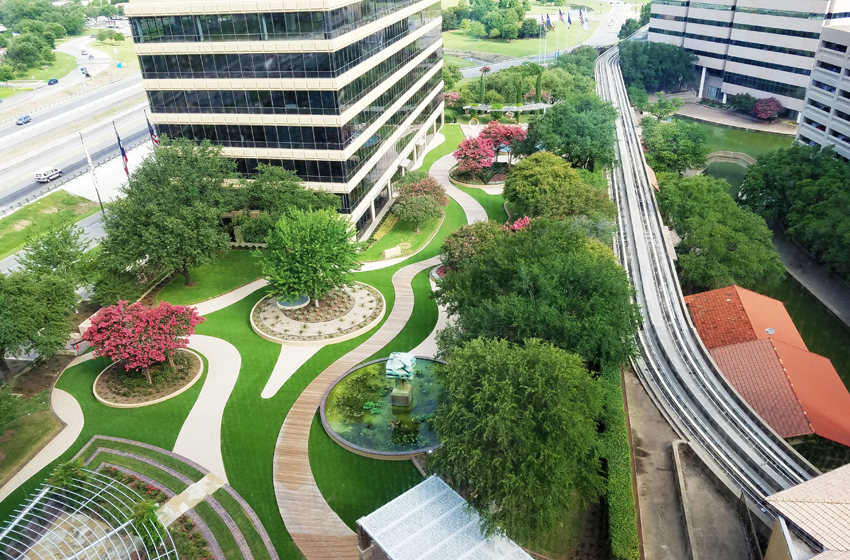
Photo courtesy of Thermory USA
The walkway decking at Gardens by the Mandalay in Irving, Texas, was designed by Complete Landsculpture and constructed of thermally modified ash.
Thermally modified white ash, spruce, and scots pine decking, cladding, and porch flooring offer great versatility to landscape architects. Because of its high durability and low maintenance requirements, thermally modified wood offers great versatility for the design of exterior surfaces whether for porches, outdoor decks, or roof patios, as thermally modified wood can withstand foot traffic as well as harsh weather conditions and still retain its aesthetic character and smooth finish.
Each fiber of the board is modified using the thermal modification process of heat and steam to achieve rot resistance to the core of the board. This provides decking, flooring, and cladding with a Class 1 durability rating. Class 1 durability is a European rating system that rates exterior wood products and their expected lifetime use. Class 1 is the highest possible rating, and it means that without any additional maintenance and with proper installation, the wood would remain resistant of rot for a minimum of 25 years or more. White ash and spruce are classified as Class 1 durability. Class 2 durability ratings indicate that the wood is resistant to rot for 20 years or more. The scots pine wood is classified as Class 2.
As a comparison with other wood species, ipê from Brazil and old-growth Burmese teak have Class 1 ratings, while most other tropical rainforest species attain Class 2 ratings or less. Domestic old-growth cedar can be classified as Class 2, although currently harvested cedar is mostly tertiary growth and meets a Class 3 standard, which indicates resistance to rot for 15 years or more.
In addition to durability, thermally modified wood provides a product with a rich, natural color that is not the result of a stain. Left untreated with UV-protectant oil, the boards will slowly age to a platinum grey finish. In addition, each board goes through a milling process that produces an extremely smooth finish, thus eliminating roughness and splinters.
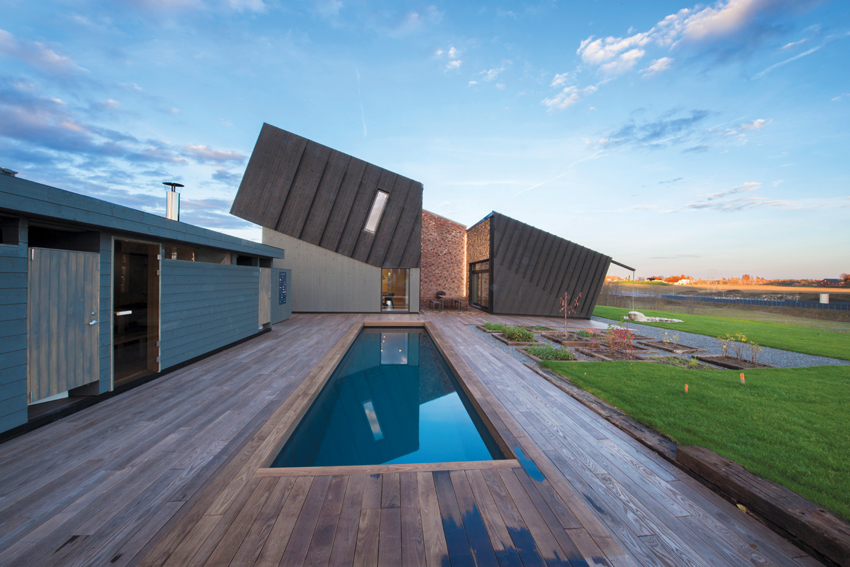
Image courtesy of Thermory USA
Shown is a thermally modified white ash decking board.
Design and Construction Flexibility with Wood
Thermally modified wood products provide extensive flexibility for both designers and contractors. Wood used as decking is durable, dimensionally stable, and retains a smooth finish. The wood can be pre-oiled or unoiled. It comes in widths of 3.5–7.5 inches and has a thickness of 0.79–1.65 inches. Thermally modified wood boards can be installed using clips, screws, or PaCS. PaCS are strips on the underside of each wood board that allow the installer to just click the board into place. The installer simply presses down on the custom developed clip strip, and the board clicks into place. The wood boards are pre-grooved with tracks for the clips so alignment is automatic. There is no need for drill bits or screws, thus creating a clean look with no hazards to bare feet.
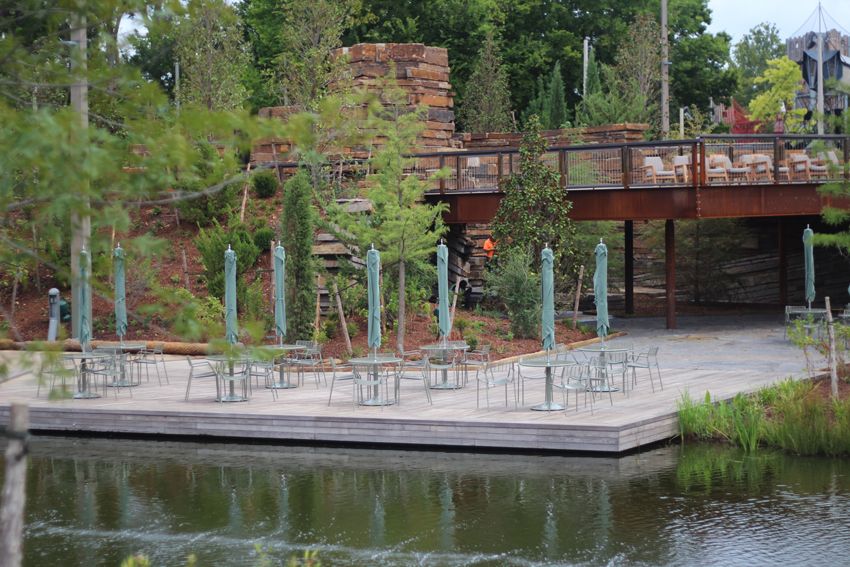
Photo: Ryoma Tominaga
Michael Van Valkenburgh Associates used ash to design an outdoor deck at The Gathering Place located along the Arkansas River 2 miles from downtown Tulsa, Oklahoma.
As an example, ash decking was used by Michael Van Valkenburgh Associates in the design of an outdoor deck for a project along the Arkansas River 2 miles from downtown Tulsa, Oklahoma. The hot summers and riverfront location inspired many of the design elements, including pedestrian land bridges and the outdoor dining deck.
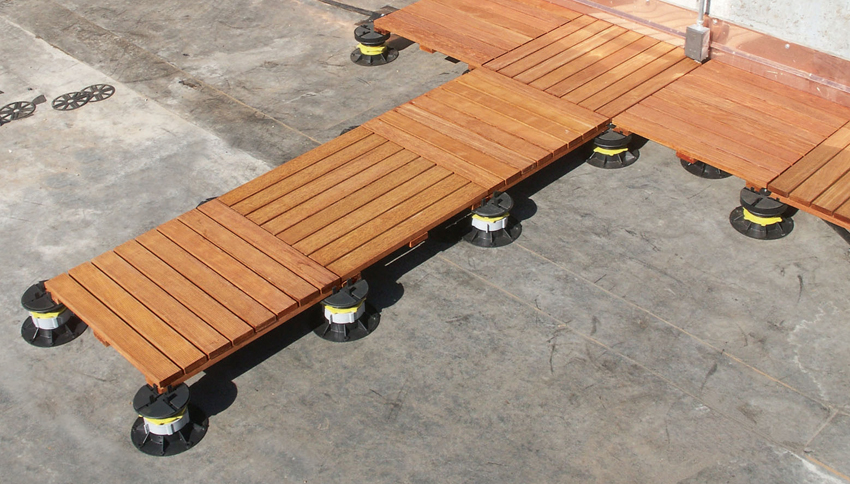
Photo courtesy of Bison Innovative Products
A pedestal system supports modular wood tiles.
Design Flexibility with Versatile Modular Pedestal Systems
Pedestal systems can be utilized over any structural surface: on structural concrete, rigid insulation, or roof membranes for rooftop decks, plazas/terraces, compacted grade, pavements, pool surrounds, or within water features. These pedestal systems are comprised of two major components: pedestals and tiles/pavers. The pedestals are designed to elevate and support a variety of surfaces, including structural porcelain, stone, granite or concrete pavers, wood tiles, composite materials, fiberglass grating, or conventional joist and plank systems.
The pedestal system offers tremendous design flexibility coupled with ease of installation. An adjustable pedestal system provides a unique and viable alternative to traditional deck-building systems for the following key reasons:
- They are available in a range of heights and weight-bearing capacities to suit a variety of applications.
- They are one of the most labor- and cost-efficient methods of creating a flat, level structure over a sloped surface.
- They use a gravity system that protects roofing and waterproofing materials without damaging or harming the surface below.
- They can support decks over occupied spaces, allowing room for electrical systems, duct work, or irrigation to pass underneath the surface material.
The pedestals can be made from high-density polypropylene plastic (comprised of 20 percent post-industrial recycled content) that is 100 percent recyclable. The recycled material content of the pedestals provides points toward both LEED and SITES certification. The pedestals are screw adjustable and easily leveled with tapered base leveling discs and/or shims, allowing the creation of level rooftop surfaces over a variety of conditions, including sloped surfaces. The pedestals can elevate and support wood tiles, concrete pavers, and a variety of other surfaces when sophisticated, commercial-grade decking is required. They are also sturdy enough to support site furnishings such as planters, tables, benches, and/or structures such as pergolas.
Design Options using Pedestal Deck Systems
The pedestals come in residential, commercial, and industrial grades, with each grade having different characteristics. Deciding which systems to specify is dependent on the support and elevation requirements of the installation. These pedestal systems provide designers with options for creating valuable outdoor spaces for owners and their clients, customers, and visitors. Rooftop decks are a way for residential, hospitality, or public spaces to differentiate themselves from the competition.
A pedestal system is also an ideal method to incorporate a water feature application onto a rooftop garden. The system conceals the water supply beneath the pedestals and surface materials and allows water to drain to the surface below for recycling. Additionally, the pedestal supports are impervious to water, mold, and most chemicals.
These pedestal systems also provide designers with the opportunity to include recessed lighting below the surface. Lighting can be selectively located to enhance the ambiance of the environment and improve visibility and safety during nighttime and/or dark conditions.
Ground-level and street-level sidewalks and storefronts can be expanded through the design of mini-decks, parklets, or pop-up parks, all of which enhance urban communities. These mini-decks, parklets, and pop-up parks can be designed using pedestal systems and modular wood tiles placed over existing ground and street-level spaces. These exterior spaces provide areas that support social connections, mental restoration, and physical activities that meet criteria under Site Design: Human Health and Well-Being in the SITES guidelines.
Fastening kits and splines facilitate quick and secure pedestal deck system installations. The fasteners attach kerf-cut wood tiles, concrete, and stone pavers or paver tray-backed porcelain tiles to the pedestals without penetrating or damaging the selected surface material. While the fasteners are hidden, they can be accessed to allow for the removal of individual wood tiles or pavers if roof maintenance, drain access, or tile replacement is required. Some pedestal systems can also be designed to resist wind uplift. It is important to consult with individual manufacturers and engineers for confirmation on the capabilities of their systems.
Modular Wood Tiles for Ground or Rooftop Applications
Typically made from dense hardwoods, wood tiles are commercial grade and available in responsibly harvested standard and FSC-certified species. Wood species include fused bamboo, cumaru, garapa, ipê, mahogany, and massaranduba. Hardwood tiles contain a rich variety of graining and coloration, are exceptionally dense, and are resistant to insects. Wood tiles can be crafted from premium-grade remnants and harvested in an environmentally responsible method designed to preserve the economic viability of rainforest hardwoods.
The density of tropical hardwood species allows for minimal maintenance. If maintaining the wood color is desired, wood tiles can be periodically cleaned and sealed. Left to weather naturally, the wood tiles will develop a silvery-gray patina. Because they weigh one-third as much as concrete pavers, wood tiles are a good alternative when surface material weight is a concern. The tiles can be laid in a parquet or linear pattern, or mixed with pavers, river rock, stones, plank decking, or other options to create unique aesthetics.
Because they are modular, the wood tiles meet SITES criteria 5.3: Design for adaptability and disassembly. The wood tiles also meet SITES criteria 5.8 because they support safer chemistry.
Site Furnishings for Enhancing Landscape Spaces
Site furnishings such as benches, tables, and planters provide enhancements to any outdoor space, as they provide more inviting areas for leisure activities and social interaction. Modular planters provide flexible options for the addition of plantings in roof gardens, small urban spaces, pocket parks, and around building plazas. Planters are available in a variety of materials, including metals, cast stone, concrete, resin, fiberglass, and wood. Metal aluminum planters offer the durability of metal with a lighter weight, making them easy to move as well as place onto rooftop decks.
Modular cubes that are constructed of lightweight, recycled aluminum are durable, low maintenance, and designed to withstand extreme temperatures. This makes them ideal for rooftop locations that are subject to extreme winds, sun, and weather. These cubes are painted using an industrial-strength powder-coating technology developed with modern aesthetics in mind. Powder coating is a dry finishing process that is applied electrostatically and cured under heat, creating a more resilient finish than conventional paint. The process does not emit any volatile organic compounds (VOCs) into the air and allows the aluminum planter cubes to be coated with any RAL (a color-matching system used in Europe) paint code color.3 The aluminum planter cubes typically contain 20 percent recycled content, are 100 percent recyclable, include drain holes and irrigation sleeves, and are made in the United States. They come in a variety of size and color choices, providing a number of design options for landscape architects.
Modular wood cubes provide another material option for introducing plants onto a rooftop garden or a ground-level exterior space. Ipê wood planter cubes and ipê wood planter cube tops offer a selection of modular design options to incorporate seating, storage, and planters into a ground-level or rooftop space. With the long-lasting durability of dense hardwoods, these wood planters and tops can withstand harsh environments. The warm wood tones and varied grain patterns provide a natural complement to wood decking. The wood planters have a polyurethane lining and drainage holes, making plant care and maintenance easy. Custom sizes and species are available as well. As a storage unit, they can be used for seasonal items like cushions or throw pillows.
Lightweight aluminum trays expand the design options for rooftop environments. Used as a containment system for architectural rocks or other deck elements, the low-clearance aluminum trays integrate seamlessly with the modular planters and wood tiles, providing designers with a palette of materials for designing rooftop environments. The trays are corrosion resistant, made in the United States, and available in a variety of standard and custom size options that offer modular integration with a pedestal deck system.
Natural Stone Materials as Design Alternatives
Stone is a natural product that can be sourced locally. It is not manufactured and is a sole-source product. It contains no harmful toxins or chemicals so it provides an environmentally friendly and healthy element for landscape projects. Stone is used for its strong physical properties, and it can be crushed and broken and sorted into various sizes for a variety of uses.
Natural stone refers to a number of products that are quarried from the earth. These products include granite, marble, limestone, slate, travertine, sandstone, quartzite, and others. Depending on the quarrying operation and extraction process, the stone can be of varying sizes and shapes.
Natural stone materials can include small decorative landscape rocks, river rocks, cobble and beach pebbles, rip rap, and large boulders. These materials provide a variety of design alternatives for the landscape architect, and because they can be locally sourced, they help projects meet LEED and SITES criteria.
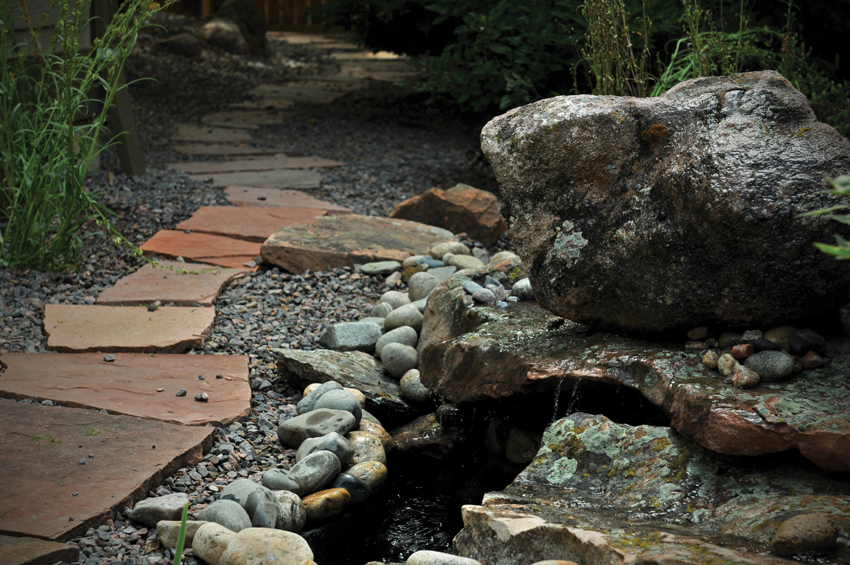
Photo courtesy of Pioneer Landscape Centers
This landscape setting uses a combination of natural stone materials. Flagstone is placed on a gravel base. Cobble or river stones are used as edging around a small water feature. Large moss rock boulders provide a means for a waterfall into the small pool.
Decorative rock is used extensively in southwestern landscapes, as it provides a xeriscape surface alternative to lawns, thus conserving on water use. There are many varied colors and sizes to decorative rock due to the geological diversity of its origin. However, decorative landscape rock is also being used in more northern climates as landscape architects look to reduce lawn areas. River rock and cobble have been shaped and smoothed by the force of water friction and also have a use in xeriscape projects. In many northeastern areas, these rounder natural stones are used in the construction of bioretention areas for rainwater management.
Rip rap and larger boulders are sized from 3–4 inches and larger. These natural stone materials are used in landscape designs both for decorative design purposes and as structural elements for erosion control. They can be used to retain steep slopes where vegetation is not practical due to maintenance issues or potential erosion issues. Moss rock is a type of flagstone or sandstone that is covered with moss or lichen. The rock itself is usually brown and red in color hues. As a naturally sourced stone, it is available in a variety of shapes and can be used to add texture and color to a landscape.
These natural stone materials provide alternatives for landscape treatments to control erosion, construct rain gardens and bio-retention areas, and, in the case of moss rock, create natural pathways or patios. Natural stone has a range of sizes depending on the type of stone.
Decorative rock ranges in size from 1⁄4-inch to 11⁄2-inch river rock or crushed rock. Cobble stone or larger river rocks range in size from 2–12 inches. Rip rap ranges in size from 3–12 inches. Boulders/moss rock range from 12 inches and larger.
Materials for Patios, Walkways, And Walls
Natural stone materials for patios, walkways, and walls include flagstone, strip stone, dimensional stone, and ledgestone. Flagstone is a flat sedimentary stone that is available in a number of colors and textures and suitable for use in pathways, patios, pool decks, or as veneers to create outdoor table and bench surfaces. Dimensional stone or strip stone can be cut into modular shapes and used for outdoor patio surfaces, pathways, or walls. Landscaping ledgestone is crafted from a variety of natural stones ranging from slate to marble. It can be cut into flat panels or rectangular block shapes and is suitable for use as cladding for outdoor projects such as outdoor kitchens. Color options include black, brown, rust, cream, and white.
Natural gravel has many useful landscape applications and provides a pervious surface that also controls erosion. Depending on the quarry source, natural gravel is available in a range of colors, including brown, rust, grey, and black as well as a color mix. The size of gravel ranges from peastone (1⁄4–3⁄8 inch) down to a very fine stone dust material. Gravel materials can be used for walkway and driveway surfacing and as a base material for pavers.
Synthetic Grass as An Alternative To Lawns
Synthetic turf has become popular as a surface for sports fields, as it reduces maintenance, eliminates the use of fertilizers, and allows for more frequent use of the fields. Synthetic grass is also becoming more popular in southern and western states for commercial and residential properties that would like a natural green lawn year round but have water restrictions. Synthetic grass requires minimal water (usually just to reduce heat buildup), and there is no need for fertilizer. Most synthetic grasses come with a warranty of 10 years.
The installation process requires an infill base of permeable materials (gravel, peastone) over which the turf is laid. The synthetic turf is usually placed in layered systems of permeable materials. The turf infill layer is placed over a drain pad, which is then placed on a sand layer. Underneath the sand layer is a landscape filter fabric, which is placed over a permeable base material. On roof gardens, synthetic grass can be laid over a pedestal system deck. When measuring for turf areas, add 10–15 percent more to the area to ensure coverage.
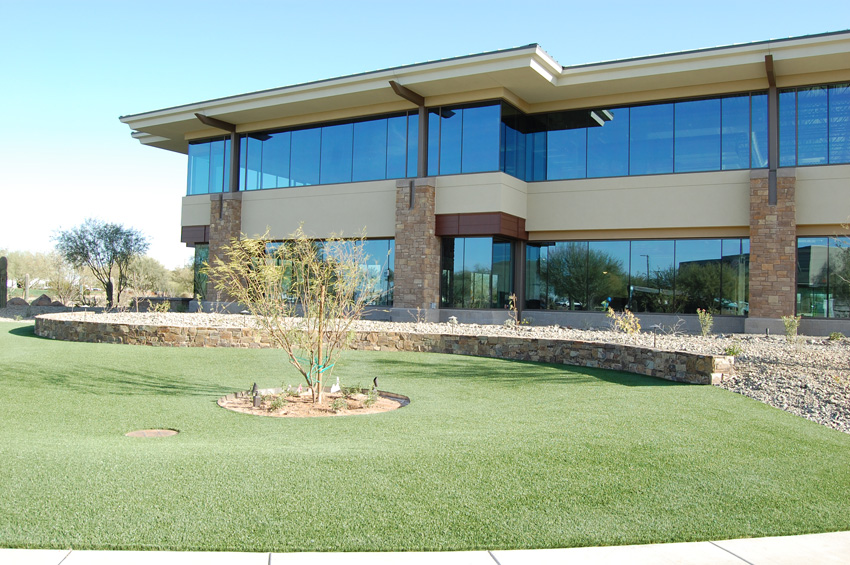
Photo courtesy of Pioneer Landscape Centers
Synthetic grass provides a year-round lawn near the entrance of this commercial property. The wall in the background is made of ledgestone, and beyond that is a bed of decorative landscape stone.
Clay Pavers: An Environmentally Friendly Material Option
Clay pavers provide the landscape architect with both quality material performance and design flexibility. Clay is an environmentally friendly raw material that has been used to fabricate bricks and clay pavers for hundreds of years. Clay pavers are fired at temperatures exceeding 2,000 degrees Fahrenheit. This process of firing provides designers with pavers that are non-fading and resilient to wear and staining. Because of this high-heat firing process, the pavers never need sealing to retain their color. And because there are no dyes used in the fabrication process, the cost of clay pavers is less than pavers that are comprised of other materials, such as concrete.
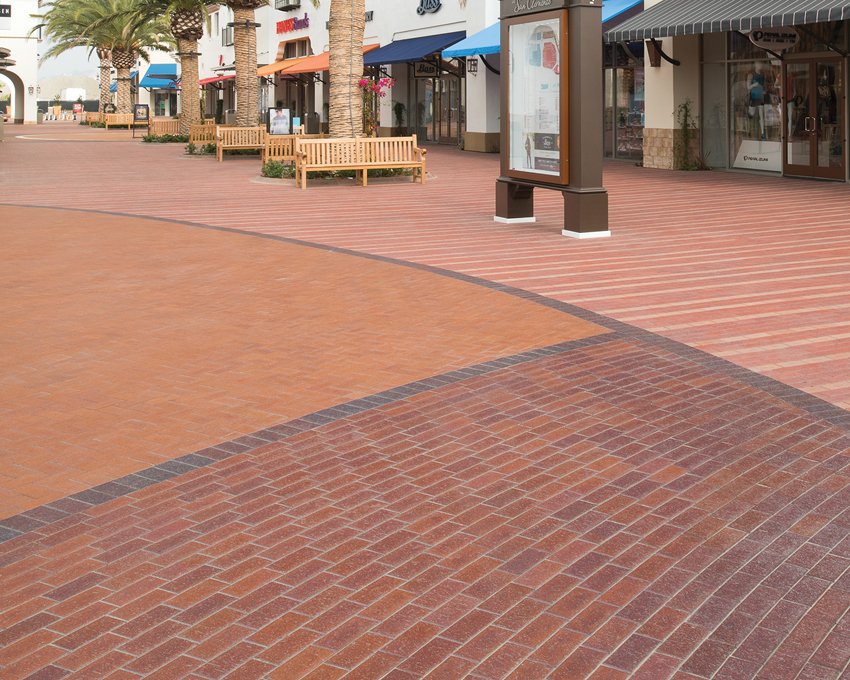
Photo courtesy of Endicott Clay Products Company
Multiple colors and patterns can help to humanize pavement scales, as seen at this plaza located in San Clemente, California.
Design Flexibility of Clay Pavers
Clay pavers come in a variety of sizes and types, including permeable pavers, relieved edge lugged pavers, pool coping pavers, Danish hand-molded pavers, bullnose paver threads for stairs, and ADA-approved detectible warning pavers. Clay pavers are used in both pedestrian and vehicular applications, including patios, pool decks and pool copings, large outdoor plazas, walkways, and driveways. Their relatively small size creates a pavement surface with a human scale. The small size also allows for the nuances of different colors, textures, and patterns to be clearly seen when standing from one vantage point within a pavement field.
Clay pavers are available in a wider range of colors. Due to the natural color of clay, the most common colors are the reds and browns of earth tones, but clay pavers are also available in buff, black, and gray. The color is typically consistent through the body of the paver, as it is fired in through the entire paver. Clay pavers are also highly resistant to weathering and fading due to their vitrified composition. As clay pavers are made from natural materials, there may be inherent color variations in pavers due to different production runs. For designers, the color variations can be addressed in a field panel and designing patterns from different production lots. Using different colors helps to break down the scale of the very large pavement areas. Borders can be laid in a different color from the field, thus adding interest to the design. Patterns that flow, repeat, and intertwine can also be added.
The texture for pavers and paver treads is wire cut. Wire-cut brick pavers are formed by slicing a brick-sized piece with a wire tool from a larger bulk- length of clay. The clay is formed and fired as a large rectangular piece, and it is then sliced into several small brick-sized pieces by pushing the wire-cutting tool through the clay. This slicing process by the wire cutter leaves a rough surface on the brick as it is pushed through the larger piece of clay. The wire-cut rough surface texture provides more secure footing for pedestrians during rain events. Some clay pavers can also be manufactured with raised bumps on the surface to serve as tactile and detectable warning strips, which are required for ADA compliance at crosswalks.
Pavement texture can be created not only by the surface texture but also by the treatment of the edges. Clay paver edges can be square, round, beveled, or relieved. Edge treatments can be uniform along the entire paver edge or variable, such as with pavers that are made to look historic. Fired pavers can also be tumbled to create “distressed” edges.
Due to their size and color variation, clay pavers can provide designers with great flexibility in the creation of outdoor spaces. Varied pavement patterns can be achieved using herringbone bond, running bond, stack bond, and basket-weave patterns. Pavement patterns should be selected based on the horizontal loads to be received and the proposed setting bed. Setting beds of bituminous sand are the most prone to horizontal movement or paver creep, so a herringbone bond pattern would be more appropriate for these types of setting beds, as this pattern best distributes horizontal forces, thus reducing the potential for paver creep. Patterns with continuous joints (running bond) do not distribute horizontal loads as well, and when using these patterns, they should be oriented perpendicular to the direction of traffic to reduce the possibility of paver creep.
Permeable clay pavers have quarter-inch lugs around the edges. These lugs maintain the joint spacing between the pavers. The joints as well as the subbase under the pavers are filled with crushed stone. Rainwater will run off the paver surface into the joints and percolate down into the subbase of crushed stone, eventually permeating down through the subgrade into the groundwater table.
In segmental paving applications, chippage can occur when pavers move against each other. This is usually due to improper installation techniques. When paver spacers are used along the edges of clay pavers, the chippage issue is eliminated. The paver spacers create and ensure the needed spacing between each paver to accommodate jointing sand while providing the crisp appearance of square edge pavers. Paver spacers come in both cross and T configurations. Each side of the spacer measures 13⁄4 inches high by 1 inch wide by 3⁄32 inch thick. There are four sides or segments to the cross-style paver spacer and three sides or segments to the T-style paver.
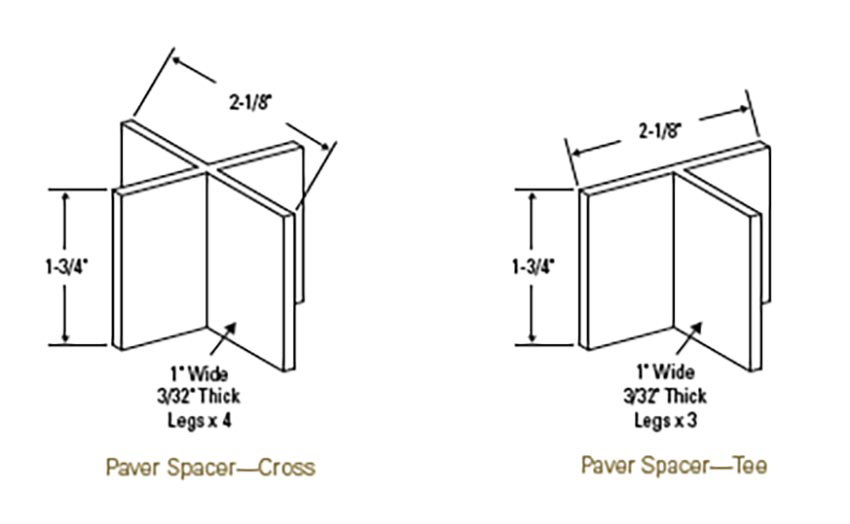
Images courtesy of Endicott Clay Products Company
Shown are two styles of paver spacers.
Construction and Design Standards for Clay Pavers
When designing an outdoor space using clay pavers, the designer must consider the intended use of the space, and select the appropriate type of paver and detail the appropriate construction application and setting bed. ASTM provides standards for pavers depending on the intended use. Pavers manufactured in the United States must comply with consensus standards published by ASTM International. Two ASTM standards provide the requirements for clay pavers for exterior use. They are ASTM C902: Standard Specification for Pedestrian and Light Traffic Paving Brick and ASTM C1272: Standard Specification for Heavy Vehicular Paving Brick.
The pavers meeting ASTM C902 are suitable for patios, walkways, interior floors, plazas, residential driveways, and commercial driveways. Pavers meeting ASTM C1272 are used in areas that will receive heavy vehicular traffic, such as streets, commercial driveways, and industrial applications.
The intended use of the area designed for clay pavers will dictate the appropriate setting bed. Setting beds provide a means of adjusting paver heights, as there can be slight dimensional variations in pavers. Setting beds can be of sand, bituminous, or mortar depending on whether the area is intended for pedestrian and light vehicular use or heavy vehicular use.4 The setting bed supports the pavers and distributes the load to the base material. Bases can be of aggregate, asphalt, cement-treated aggregate, or concrete, again depending on the intended use and application of the clay pavers.
Winter Maintenance Considerations
For maintenance in cold climate areas, snow removal and deicing applications should be evaluated for areas designed with clay pavers. Blades on snow equipment should be set high enough so as not to scrape the pavement surface in a manner that causes chipping. Rubber or urethane blade edges can also be used. If snow is intended to be stockpiled onto areas with clay pavers, the load capacity of the pavement must be adequately designed. There are a number of chemical products available for preventing and removing ice from pavements. Calcium magnesium acetate and urea are products that perform well and reduce potential staining of the pavement surface. Calcium magnesium acetate performs more effectively at lower temperatures. Rock salt is not recommended as it contains calcium chloride, which may cause efflorescence on the pavers.
Clay pavers can be laid over hydronic snow-melt systems, which eliminates the need for ice melt applications and in some cases can eliminate the need for plowing or snow clearing. Hydronic snow-melt systems consist of plastic tubing networks that are laid below the pavers, usually cast into a concrete slab. Sometimes the tubing is incorporated into the bedding material underneath the pavers. A heated liquid is pumped around the tubing system during near and subfreezing conditions to maintain a pavement temperature that is slightly above freezing. This prevents the accumulation of snow and ice.
Clay Pavers for Special Applications and Conditions
Clay pavers can be used to cover suspended decks and as permeable paving systems. When used as a pavement surface on a suspended deck, the designer must consider the prevention of water penetration into the structure and deal with elastic deflections. A waterproof membrane should be designed into the structural slab to prevent water penetration. Horizontal drainage mats with a 2 percent slope will help with water drainage. If the structural slab is located over a habitable space, insulation may be required to prevent heat loss in the building. Both foamed concrete and extruded polystyrene have been used for insulation layers depending on the application and intended use of the structural slab.
Clay pavers used as permeable pavement will reduce or delay rainwater runoff into drainage systems. The permeability in the surface is achieved by creating wider joints that are filled with permeable aggregate in place of sand. The pavers are also laid over a permeable setting bed and base of aggregate and stone. The water can thus penetrate through the joints into the base layer and be stored in the base layer until it infiltrates into the subgrade.
Clay pavers can be used in a wide variety of applications, and with the variety of textures and colors, they provide designers with a number of options for creating inviting and durable pavement surfaces. As clay is a natural material, it meets LEED and SITES criteria that provide points for regional materials. Those clay pavers that are used for rainwater management help to meet LEED criteria 6.1 and 6.2 for Stormwater Design. And using clay pavers in creating plazas, walkways, patios around building exteriors, and streetscapes will provide designers with possible points for LEED Pilot Credit 14: Walkable Project Site, LEED Pilot Credit 78: Design for Active Occupants, and SITES criteria 6.4, 6.5, and 6.6 under Human Health and Well-Being.
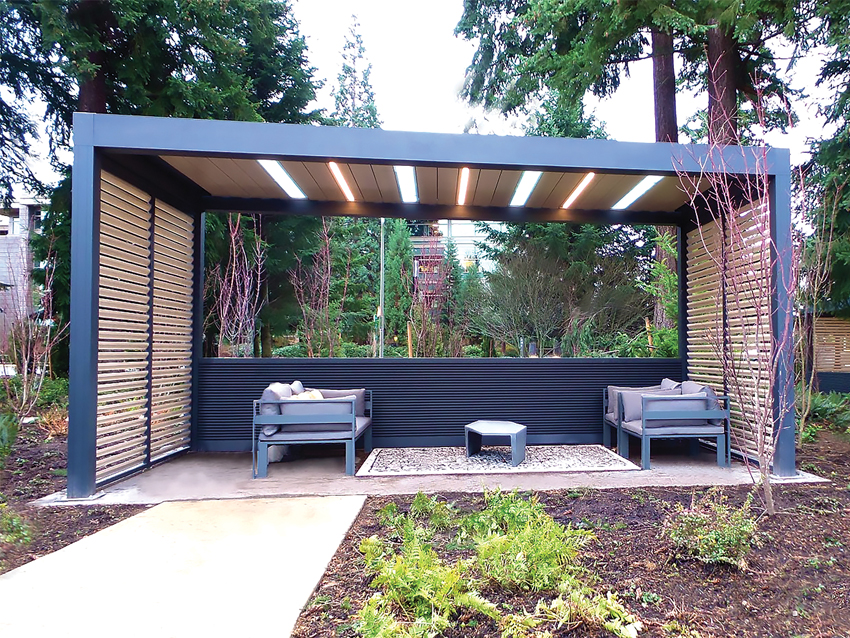
Photo: John Shaw
An outdoor structure can extends design opportunities within the landscape as well as provide health benefits to users.
Expanding Outdoor Spaces With Outdoor Structures
Current design strategies put a great deal of emphasis on expanding outdoor living spaces, as outdoor environments provide both mental and physical health benefits. Outdoor structures can be extremely flexible in size, configuration, and design, giving architects and designers maximum creative options in designing outdoor environments. Outdoor structures are available with decorative options to control sun shading, wind and bug protection, and privacy, thus providing protection from sun, rain, wind, and flying insects and extending the use of outdoor spaces.
Outdoor structures are engineered so that they can enhance recreational and work environments for health-care, hospitality, commercial, and residential settings. These outdoor structures are designed to withstand and function in a number of weather conditions, as the roof louvers and side panels keep out sun, rain, and wind. These structures are designed for hurricane-force wind loads, with a Miami-Dade rating for certain sizes, and have temperature and rain sensors built in so that roof louvers will automatically close at the start of a storm. Side panels can be either shade screens or glass panels, and both help to buffer against wind.
The outdoor structures are available in a number of sizes and design options. Sizes range up to a maximum size of 14.75 feet x 20 feet to even larger if pergola structures are joined. Pergola structures include:
- Square design models that have either a tilting and/or retracting louvered roof or an inoperable stretched fabric ceiling with a drainage system above.
- Incline design models that have retractable fabric roof coverings.
- Frame-only structures with no louvers or fabric coverings. These models allow for the planting of vines on the structure.
Structures are constructed of powder-coated aluminum with stainless steel hardware. The shade fabric is fire rated.
Options for Enclosing Outdoor Structures: Shades and Sliding Panels
Outdoor structures offer a sun-protection roof system through louvers. Louvers work via rotating blades, with each blade channeling water to the beam. The extruded aluminum blades rotate up to 150 degrees and thus enable the user to decide how much sun protection and/or ventilation is required. The closed louver blades form a waterproof roof under normal shower conditions. A gutter system drains the rainwater in the beams and down the columns of the outdoor structure.
Designers have the option of having up to five glass skylight blades in the louver system. The skylight blades obviously let in more sunlight during the day. There is also an option of having LED louver blades to provide nighttime lighting for the interior of the structure. Other LED options include cove-mounted up and/or down lighting and vertical column lighting on the inside corner of columns in either white or RGB color. All of the LED options are dimmable.
Shades offer wind and rain protection along the sides of the outdoor structures. Shades are operated using the same remote control and employ a “zipper” roll shade system that secures the fabric edges on the sides to keep wind and bugs outside. The zip shades come in various sizes. The Medium size option is 157.5 inches wide x 106.35 inches high. Large size options are 236.25 inches wide x 133.75 inches high. The fully integrated zip shades can be hidden inside the beam as an option for maximum passage height under the beam, or shades can be surface mounted in a matching headbox as another option depending on conditions and structure type.
Shades have a locking zipper side channel, which allows the shade to keep out wind, rain, and insects. Side channels were originally created for Japanese bullet trains, when speeding through tunnels pushing a shock wave of air that would blow roller shades out of their side channel. Now perfected for exterior use, the zipper fabric lock keeps the shade flat and smooth, and seals the edges to keep bugs out. It can even keep golf balls from breaking windows.
Shades can be mounted either on the interior or exterior of the outdoor structure, but the exterior mounting provides several advantages that also help to meet LEED and SITES criteria:
- With exterior shades, the heat stays outside the structure. The designer can use darker fabric colors to improve shade visibility without concern of heat buildup on the interior of the structure because of the locking zipper side channels.
- Exterior-mounted shades keep the mechanicals on the exterior of the structure so they are not visible from the inside.
- Exterior-mounted shades keep the interior of the structure and the windows cleaner if a combination of exterior shade and glass panel are used for the outdoor structure.
All exterior shades meet 80-mph wind resistance against the windows and 31-mph wind resistance in the open. They meet a Wind Class EN13561. A wind-resistance class is determined for every outdoor shade, screen, and blind system, accredited after strict laboratory testing as specified in the European Standards. The EN13561 references the testing standards for External Blinds and Awnings. Wind-resistance classes are set based on wind speeds:
- Class 1 = wind speed 28 km/h (beaufort scale 4 – 40 N/m)
- Class 2 = wind speed 38 km/h (beaufort scale 5 – 70 N/m)
- Class 3 = wind speed 49 km/h (beaufort scale 6 – 110 N/m)
Note: The Beaufort wind scale was developed and named for British admiral Sir Francis Beaufort (1774–1857) who developed the scale in 1805 to help sailors estimate the winds via visual observations. The scale starts with 0 and goes to a force of 12. Hence the term N/m, which stands for Nautical miles.
The shades have hidden electrical wiring and use a smooth side channel for stability. Both the louvers and shades are motorized and UL electrical listed. Medium shades can also be solar powered because of a photovoltaic cell that can be mounted on the shade enclosure or nearby.

Photos courtesy of Renson Inc.
This outdoor structure features rotating roof louvers and exterior side louvers.
Outdoor structures meet the following LEED and SITES criteria for designers.
Sustainable Sites 8: Light Pollution Reduction (1 point)
The motorized shades contribute toward 1 point with automated solutions for shading devices, eliminating light pollution by blocking artificial light to the outside during evening hours.
Sustainable Sites 1: Energy & Atmosphere (4–11 points)
The mechanized and solar sensitive shading systems contribute toward up to 11 points by helping to optimize the energy savings of the artificial lighting systems and HVAC.
LEED Indoor Environmental Quality 6.1: Controllability of Systems – Lighting (1 point)
The shading systems contribute toward 1 point through the management of scenes between the lighting and solar-protection systems.
LEED Indoor Environmental Quality 6.2: Controllability of Systems – Thermal Comfort (1 point)
Motorized shades contribute toward 1 point by the dynamic insulation solution interacting with the heating and cooling systems.
Outdoor Spaces Benefit People and The Environment
Outdoor spaces provide many opportunities for landscape architects, architects, and designers to expand a project’s used beyond the building walls. Particularly in this time of COVID-19, ground-level plazas, patios, outdoor decks, outdoor structures, and roof gardens provide opportunities for healthy socialization, as they offer additional room for building users to interact in compliance with social distancing. The material palette for expanding into outdoor spaces includes thermally modified wood for decking, a variety of natural stone and permeable gravel surfaces, brick pavers, modular deck tiles and planters, and pergola structures.
There are a number LEED and SITES strategies that can have a positive impact on a person’s health and well-being and well as the environment. On-site plazas, roof gardens, and outdoor decks that are easily viewed and accessible from a building interior benefit building users and occupants while also providing LEED and SITES credits. Wood decking, clay-paver plazas, metal and wood planters, and wood-tile roof plazas are products that provide designers with multiple options for landscape architectural placemaking. Products that are sustainably produced and transported and provide reduction in heat island effect help to meet LEED and SITES criteria while also producing environmental benefits. Outdoor spaces that provide opportunities for physical activity, social interaction, safe site accessiblity, and equitable use of a site meet multiple criteria in the Human Health and Well-Being section of the Sustainable SITES rating system. And landscape architectural designs that expand user opportunities outside of the building provide wholistic benefits to both people and the environment.
END NOTES
1Cellulose is an insoluble substance, which is the main constituent of plant cell walls and vegetable fibers such as cotton. It is a polysaccharide consisting of chains of glucose monomers.
2Hemicellulose is any of a class of substances which occur as constituents of the cell walls of plants and are polysaccharides of simpler structure than cellulose.
3RAL is a European color-matching system that defines colors for paint, coatings, and plastics. The RAL color standard is administrated by the RAL Deutsches Institut für Gütesicherung und Kennzeichnung. RAL is the abbreviation of Reichs-Ausschuß für Lieferbedingungen und Gütesicherung. This name can be translated in English as National Commission for Delivery Terms and Quality Assurance.
4A bituminous setting bed is basically a sheet mix of asphalt, screeded by hand similar to how a sand setting bed is screeded. The bituminous setting bed is more expensive than sand set pavers, but it provides more longevity in vehicular applications.


